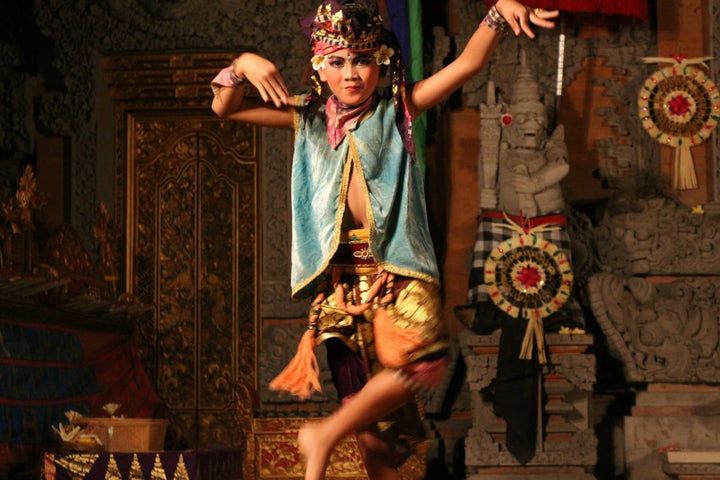
I land in Denpasar, Bali, Indonesia, into a dense sultry night. When I hand over my passport at immigration, I am puzzled to see an offering placed on the counter just in front of the immigration officer. The offering consists of dried palm tree fronds woven together and folded neatly into a miniature box. Inside the box there is a cookie, a pinch of rice, and a small red tropical flower. Why was it here? I wondered: Could this be an offering to the gods of immigration?
In Bali one sees offerings everywhere—on sidewalks, streets, on thresholds, on statues of Hindu gods and goddesses. Inside the offering basket, which can range in size from miniature ones, which are often placed on the ground, to larger baskets laid at the feet of Hindu figurines. There may be a hibiscus flower, or perhaps an orchid, or simply red or pink petals, sometimes arranged in the shape of a mandala. Usually a cookie or candy or a bit of rice are placed beside the flower, and sometimes a cigarette. The simplest of offerings consists of a small shred of a bamboo leaf with a pinch of rice placed on it.
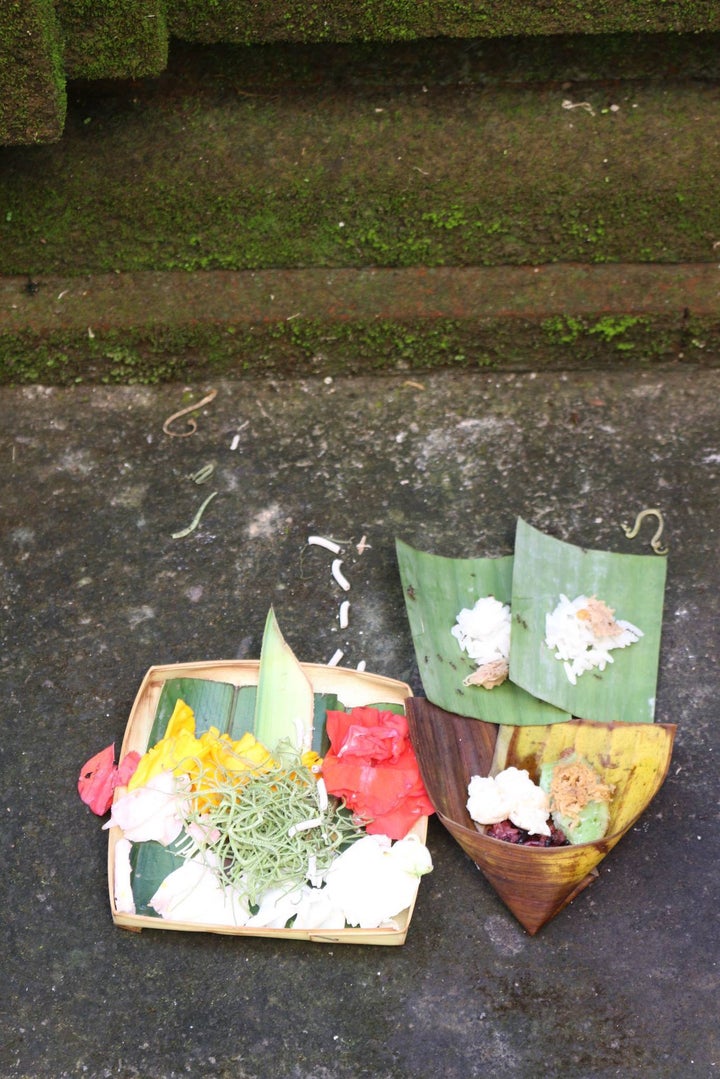
I remember my last visit to Bali the previous year over Chinese New Year. I stayed at a small family run hotel deep inside a courtyard off of Monkey Forest Road in Ubud, the cultural center of Bali. I am an early riser, and on my first morning in Bali I stepped outside of my room for a breath of fresh air. Immediately I pulled back, hiding in the doorway. I did not want to disturb the ritual that was taking place just a few footsteps away from me. The hotel owner’s wife, dressed in a beautiful orange and pink sarong and white blouse, with a white orchid tucked in her long black hair, looking as though she had just stepped out of a Paul Gauguin painting, was holding a woven palm basket filled with the paraphernalia of offerings in one hand, and was fanning smoke from a burning incense stick towards a stone statue of a Hindu goddess with the other. She took two red hibiscus and placed them behind each ear of the goddess figure. Finally, at the goddess’s feet, on the stone pedestal, she left a small glass of coconut milk, a portion of rice, and a miniature bamboo basket filled with orchid blossoms. She moved gracefully, all her gestures inspired with love and care. I was transfixed. I could not pull my eyes away from her. As she was finishing her meditation and turning to move towards the next statue, she noticed me, half hidden in the doorway, watching her. Our eyes met and locked. We smiled at each other. Mine was a hesitant shy smile, an embarrassed smile at getting caught watching her in an intimate moment of meditation and prayer. Hers was a warm, deep smile that emanated joy and kindness.
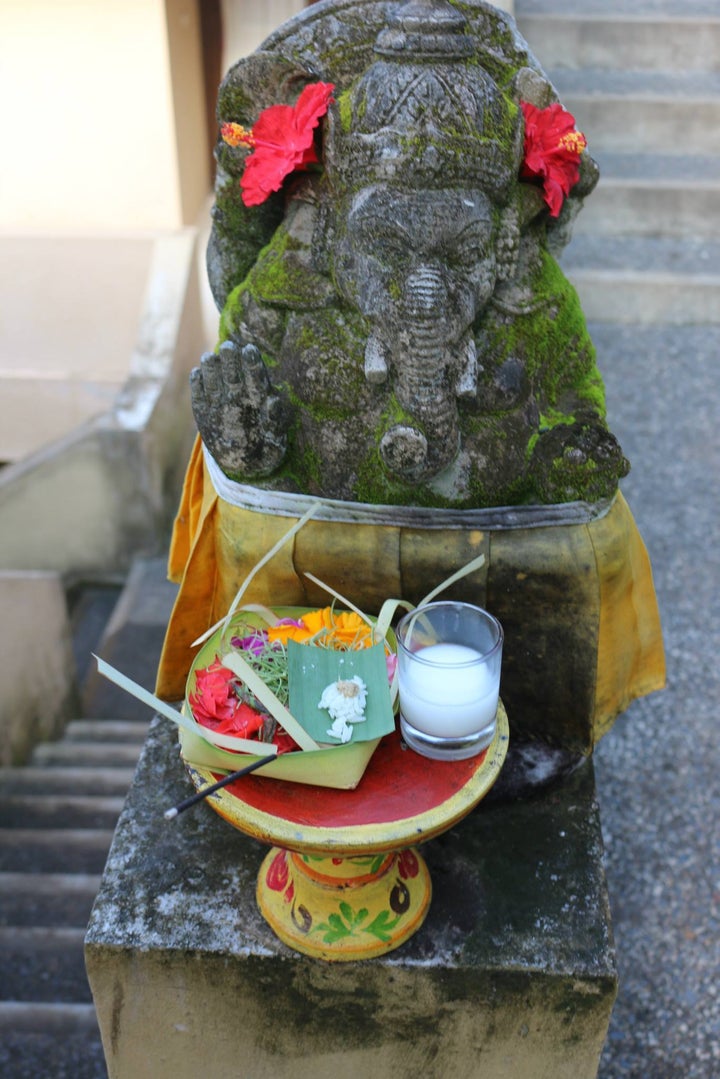
I pass through immigration, retrieve my baggage, and am greeted by a driver sent from the hotel on the beach in Legian, where I will be staying for three nights. I sit down in the van and the driver hands me a cool wet towel and a bottle of cold water. I am grateful and I thank him. This is Balinese hospitality.
The driver tells me his name is Putu, indicating that he is first born in his family, according to the Balinese naming tradition in which specific Sanskrit names are used to denote birth order. The firstborn is "Wayan" or "Gede" or "Putu;" the second born is "Made" or "Kadek;" the third born is "Nyoman" or "Komang;” and the fourth born is "Ketut.” The same names are used for males and females alike. Balinese families are very large. After a family has run through the cycle of names, if more children are born, the suffix “return” is added to the name. Therefore, in one family, for example, you can have “Wayan” and “Wayan Return.”
I ask the driver about the meaning of the flower offerings one sees everywhere in Bali, especially those underfoot on sidewalks and streets.
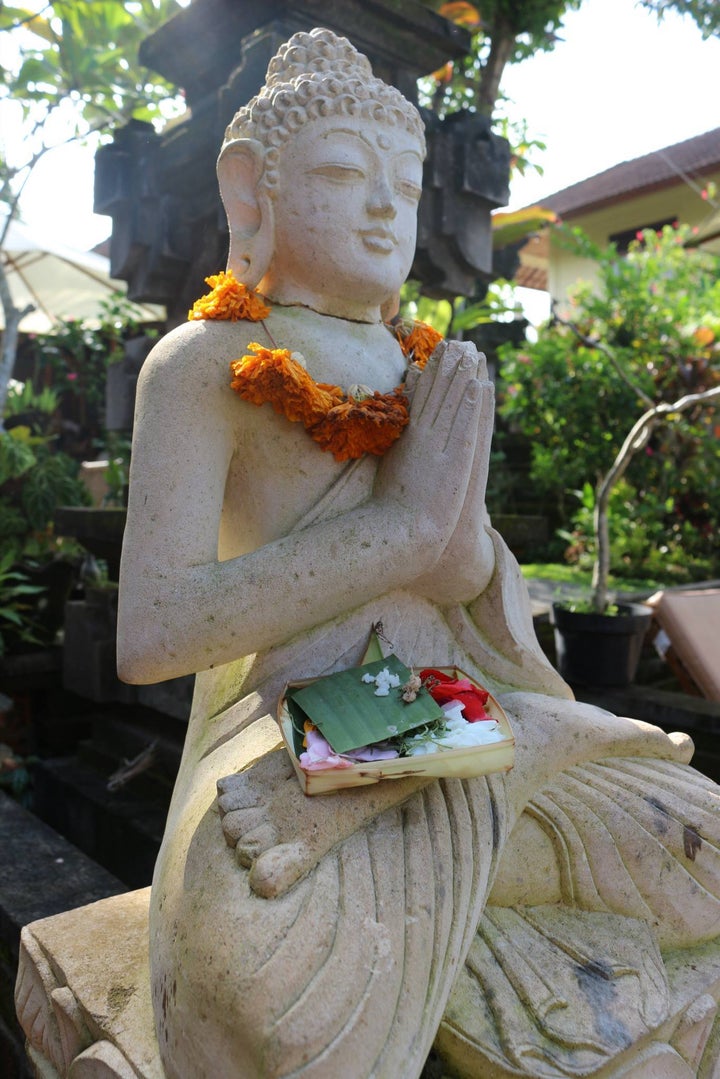
“We are Hindu in Bali,” Putu says. “The tradition of leaving flower offerings low on the ground is to appease the evil spirits.”
“Why appease the evil spirits?” I ask.
The offering baskets seem too lovely to waste on evil spirits.
“So that the evil spirits would not cause trouble for us,” Putu says.
“What kind of trouble?” I ask.
“Oh, fights in the family, bad feelings, illness, that sort of thing.”
“And so you feed them?”
“Yes. We must feed the negative spirits every day. We must tend to them. Just like you tend to a dog. If you neglect to feed your dog one day, your dog will bite you. So, we leave the evil spirits a flower offering and we add a cigarette, or a lolly, or some nuts or rice to feed them. The offerings that are placed up high are for the good spirits. There must be a balance between good and evil. We must accept both. In order to live in balance, we cannot ignore either one. This is what we do here in Bali, and that is why we live a peaceful life. We do not have war in Bali, not like in other places.”
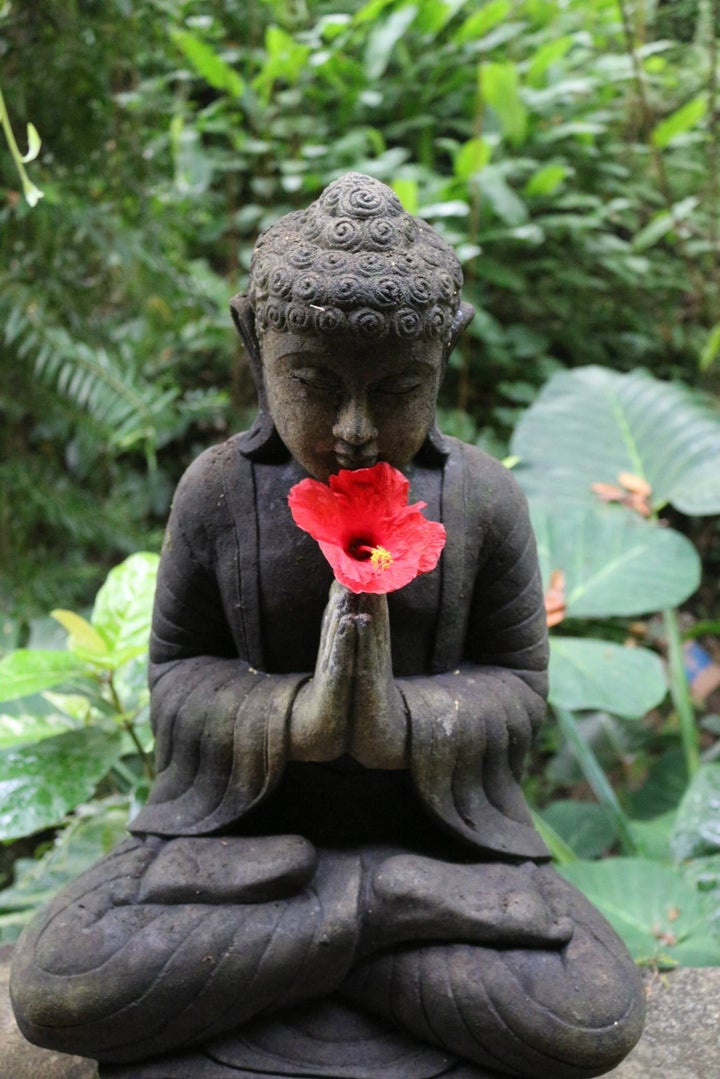
We pull into the hotel driveway. I retire to my little bungalow, dark under the veil of night, grateful for sleep after two long flights. Early the next morning I venture out onto the beach. Enormous waves rhythmically break and crash close to the shoreline. I’ve never seen waves so tall. So powerful. So devastating. These are surfing waves. These are not waves to be toyed with. I spend the day swimming in the ocean, allowing the powerful waves to knock me down and drag me back and forth in the rhythms of the Bali Sea until my body is scrubbed clean and smooth as sea glass.
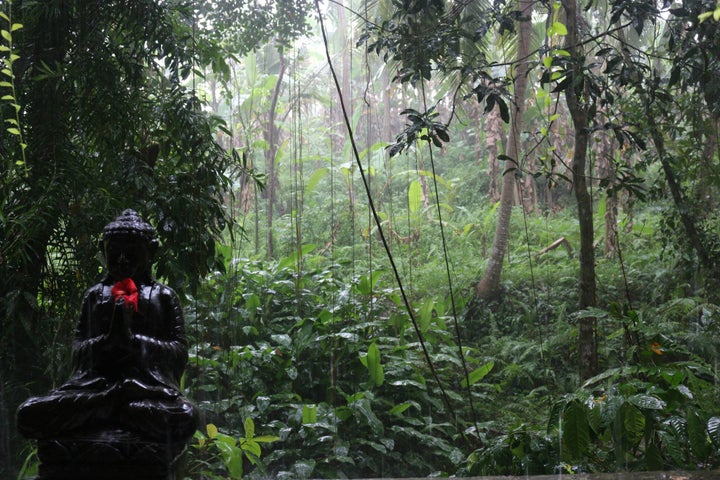
As my days in Bali pass, I begin to better understand the meaning of the morning offerings. Some may watch an offering to a statue of a Hindu god or goddess and may think that the ritual is primitive; that the Balinese are worshipping stone statues with elephant trunks. They even wrap skirts around them! But what the skeptics don’t understand is that the statue itself, and the ritual of the offering, serve as a prop to help the person making the offering center his or her mind on prayer and on good intentions, on positive energies, while keeping negative thoughts and energies at bay. By beginning one’s day by fending off negative intentions, by performing the daily ritual of placing baskets low on the ground to feed the evil spirits, and by inviting positive thoughts by placing baskets filled with flowers and sustenance up high for the gods and goddesses, one disciplines one’s mind to bend towards the positive, to consciously choose positive thought over negative. And in Bali, that makes all the difference.
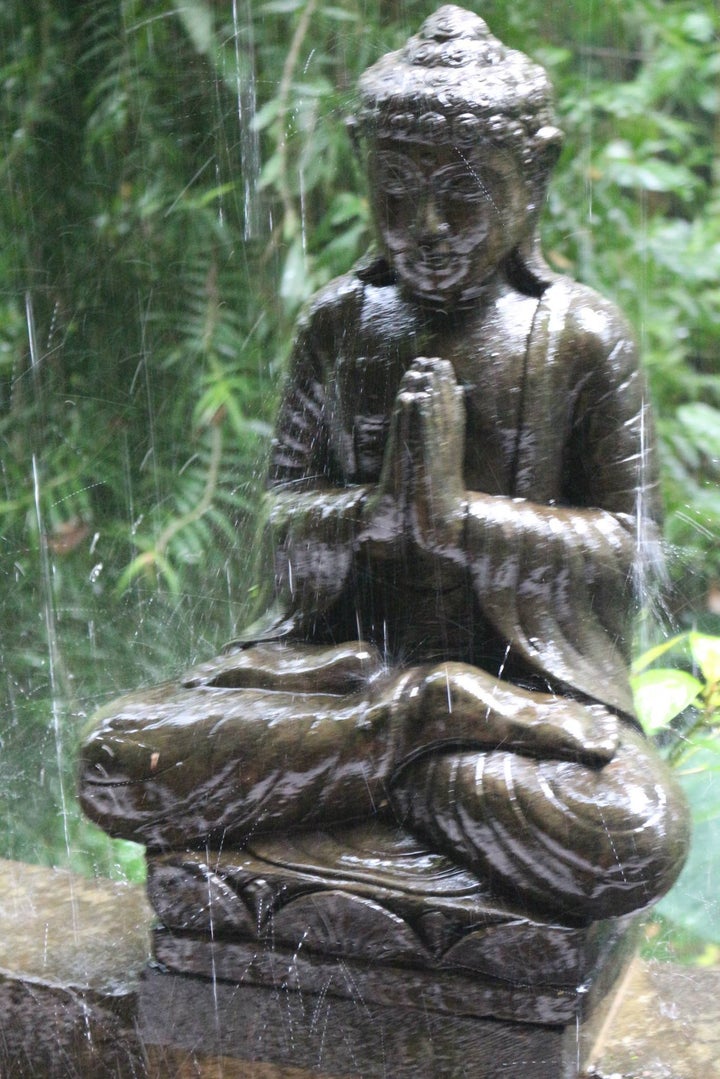
I believe this is the reason why in Bali you can observe regular people going about their everyday routines with a certain joyfulness that is not to be misunderstood as simple-minded. Nor is it to be confused with false deception or a servile stance tailored towards the needs of the tourist. It is real. It is sincere. It is dignified. It will happen whether the tourists are there or not. It is the result of a disciplined spiritual practice and a training of the mind.
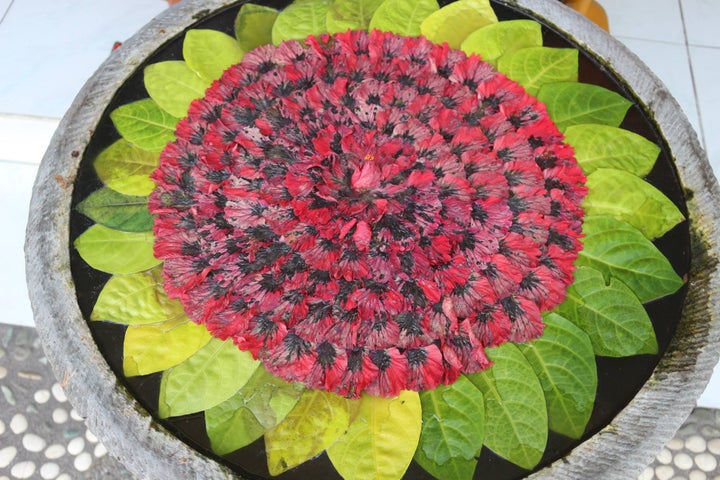
The next day I hire a driver for the day for 500,000 Indonesian rupiah ($38). My driver’s name is Gede, another first born. He is a cheerful young man with thick curly hair and a round face. Gede apologizes profusely for his English, which is actually quite good. I ask Gede to take me to Tanah Lot. In the Balinese language Tanah Lot means “land in the sea.” Tanah Lot sits on a large outcropping of rock just off the coastline of the town of Tabanan. Although Tanah Lot is not far from Kuta, where I am staying, it takes an hour to reach it because of the dense traffic. In recent years traffic jams have become a problem in Bali. Besides cars, motorbikes clog the streets.
“There are five million people in Bali and five million motorbikes,” Gede says and sighs as we sluggishly weave our way through traffic. Motorbikes whizz past carrying mothers, fathers, with two, sometimes three, children clinging to their backs. Gede narrowly misses a woman with a toddler balanced between her motorbike’s handlebars. “Too many accidents with these motorbikes,” Gede says.
I understand his stress over negotiating this traffic. Motorbikes swarm around us like hundreds of mosquitoes darting out from all directions. All a driver can do is hope not to collide with any of them.
“Isn’t there any public transportation?” I ask.
“There are buses between cities, but they run very infrequently. People need to get to work, so they rely on the motorbike.”
Finally, we get out of the urban area and enter into small roads that wind through lush green rice paddies. Closer to the coast, luxury homes have been built over the rice paddies.
“A few years ago there was nothing here but rice paddies,” Gede says, pointing out the window at a few newly built homes. “All this is new.”
“But who will grow the rice if all the land is covered with buildings?” I ask.
Gede shrugs. He has no answer for my question.
As we drive Gede tells me about the Dutch colonization of Bali. “It wasn’t a civilized colonization, like the British in Hong Kong,” Gede says. “Under the British the colonized people could at least go to school and be a part of the government. Under the Dutch the Balinese people were kept as laborers and servants. We could not go to school then. We fought for our independence in 1945 and 1946.”
As Gede speaks I remember South African and the lessons learned on the edge of the Kalahari Desert. There too, Dutch Apartheid was brutal.
The road winds back towards the coast and we enter Tabanan. We park and walk past streets lined with souvenir shops towards the pedestrian path along the cliffs overlooking Tanah Lot. Nothing can prepare me for the stunning sight out on the rocks below. Two broad sweeping stone staircases spiral upwards from the sea into a temple, half hidden by a shock of leafy green and vines. Pelinggih meru, or multiple roofed towers, peek out. Powerful waves break against the back temple walls, sending white spray pouring down from above as though it were an eternal rain storm. Between the two sets of stairs there are three deep caves. The waves have battered at the base rock over the centuries, carving it away, and yet the temple remains standing: a testimony to how our human bodies, along with all our human frailties, come and go, and yet the temple in the sea remains.
Gede tells me that the specific site to build the temple was discovered through meditation by holy men in the 11th century. Wikipedia tells me that Tanah Lot is claimed to be the work of 16th century Dang Hyang Niratha, who spent the night on the rock and felt that it would be an appropriate place to worship the Balinese sea gods. He directed local fishermen in the area to build a shrine on the rock. At the base of the rocky island, venomous sea snakes are believed to guard the temple from evil spirits and intruders. Tanah Lot is one of the seven sea temples on the Balinese coast.
Gede and I stand on the cliff above, gazing down at the ragged beauty below. Down on the rocks a group of Indian women hitch up their saris and wade into the sea, moving slowly and surely towards the temple, their colorful silk scarves trailing across the water behind them. I decide that I want to cross the water to the temple. I tell Gede that I am going, and ask him if he would like to come. He shakes his head. “No thanks,” he says. I climb down from the cliff to the rocks and wade through the sea, searching with the balls of my feet for footholds to keep my balance on the slippery stones below the water’s surface. My sandals are soaked through. The hem of my dress is heavy and waterlogged. I do not care. I rather like it—this feeling of immersing myself into the sea, as though I were being baptized anew.
Inside the cave, I find three older men dressed in white shirts and gold and white patterned sarongs. One of them directs me to drink fresh water from a spring bubbling up from an underwater source deep within the cave. I drink, and the water tastes cool, clear, fresh. This is the water of blessing and renewal. After I have drunk from the spring, the second man dabs rice on my forehead and places a white hibiscus flower behind my ear. The third man holds out a basket for a donation.
Newly blessed, I climb the wet stone staircases that winds around the outer wall of the temple from the left. The wall that curves alongside the staircase is carved in the shape of a snake with a serpent’s head. At the top of the steep staircase, a Chinese girl stands balanced on the wall’s rim, her arms thrown out wide, her long black hair blown forwards by the insistent wind, half covering her face. She cocks her head to the side, mimicking the gesture of an inquisitive crow, posing for her boyfriend, who takes her photo on his iPhone. I move past them, climbing the stairs to the very top, where I gaze out at the Bali Sea. The same waves that I swam with yesterday and early that morning crash just beyond the temple, splashing white sea spray against the temple’s outer walls. I breathe in the sea air, exhaling, inhaling, grateful to the holy men who have blessed me, and the ones before them who knew through meditation to build their temple here, to trust in the forces of nature. Their vision must have shown them that in this place, where sea meets rocks, there is intrinsically more power than in the great cathedrals of Europe.
As I wade back across the water, in the cave across from Tanah Lot, under the cliffs, an old man crouches among a pile of offerings. On his lap he holds a snake; it is one of the venomous snakes that guards the temple. For a donation, he allows tourists to pet the snake or to take a photo. Several Chinese tourist have gathered around him to take selfies.
We leave Tanah Lot and drive inland to the temple Pura Taman Ayun. This temple was built in the 1600s by the King of Mengwi, Pura Taman Ayun. The descendents of the royal family still sponsor the temple and the beautiful gardens surrounding it. Puras are designed as open air places of worship within enclosed walls and surrounded by a moat. They are connected with intricately decorated gates. The space is divided into three mandala zones according to a sacred hierarchy. We first walk through the nista mandala, the outer garden, a public space used for religious gatherings. We pause before the second gate, the madya mandala, an intricately carved stone tower. “Here, you must leave all your negativity behind,” Gede tells me. “You must leave it behind, so that you may enter the main section of the temple.”
The strong stone gate standing before me helps me focus my thoughts and discard the negative. I focus for a moment, searching my mind to make sure that I have uprooted all my negative thoughts, and then I pass through. The main area of the temple, the utama mandala, is surrounded by a moat. We walk around the outer rim of the moat, viewing the inside of the temple complex with its pelinggih mehru, its multiple roof towers, each made of thatched grass and separated from the next with a space, each roof becoming proportionately narrower, culminating with the smallest roof on top, giving the tower a cone-like look.
“Each of the roofs,” Gede tells me, “represents one dimension.”
I remember the five levels, or dimensions, of the ruins of the cathedral façade in Macau. Each level representing a level of spiritual consciousness. The Balinese have eleven. I wish that I could speak Balinese, so that I could learn more about this religion, about its fine-tuned levels of consciousness and spirituality.
As we walk out of the temple complex, we come across an old man sitting cross-legged inside a thatched roof pavilion with walls covered with whimsical paintings of Ledong dancers and scenes of villagers living out their daily lives against a backdrop of rice paddies or rain forests. He is wearing a red-striped shirt and a blue sarong. He has just completed a painting of a dancer with her hands folded daintily under her chin and hundreds of white blossoms bursting around her head. She is wearing a gold crown and gold earrings. Her blouse is decorated with flowers painted in a pointillist style. The painting, and several other paintings of dancers beside it, are an intriguing cross between traditional Balinese imagery and modernism. The artist picks up the wet painting and sets it against the wall.
We sit down to talk and Gede translates for me. The artist tells us he comes from a family of artists and learned to paint from his father. He imagines his paintings in his head and then he paints them from his vision. I am reminded of William Blake, the 18th century poet and artist, who claimed that his fantastical paintings were visions from God. I look over the paintings and I think that I would not mind living this artist’s life—sitting beside one of the most beautiful temples in Bali, painting from my imagination. My eye is pulled into a large painting of village life played out in detail among tropical plants and trees with Mount Batur looming in the background. I feel as though dozens of stories were playing out simultaneously on a two-dimensional plane. I remember the Dafen Artists’ Village, that haven of copyists, where an original work of art is hard to come by and the mark of a great artist is how many times his or her image has been reproduced. Although there are iconic images that repeat themselves in Balinese art, individual artists play with those images, bringing in their own creativity, making each painting unique.
I tear myself away from the paintings. I still have two more places to visit that day. I had arranged to visit two schools: the Canggu International School and the Green School. When I travel, if it is possible, I try to visit schools. In Bali I did not have the contacts to visit a local school, but I had been able to make arrangements to visit two international schools.
The Canggu International School was started in 2001 ago by a Balinese man and his Dutch wife. When I arrive at the Canggu International School it becomes quickly evident that this is a family-oriented school; it's apparent from the care one sees everywhere on campus, from cultivated green spaces where students can unwind, to student art on display, to the principal, who takes time away from her administrative work to show me around. The school serves a local international community and follows both the Indonesian curriculum and the International Baccalaureate. I ask the principal to tell me about the Indonesian curriculum.
“Well, for one thing,” she says, “every student must chose a religion and must study it. It does not matter which one you choose, whether it is Hindu or Christian or Muslim, as long as you chose one.”
I find it interesting that every student must follow a spiritual path and study its theology. No agnostics or atheists are tolerated in Indonesia. I like the philosophy of the Canggu School. Too many international schools graduate students who of necessity must leave their home countries because their education is not in line with the local curriculum. This school gives its graduates the option to chose. This school operates in harmony with its community.
From the Canggu International School I head to the Green School, which was made famous by its founder, John Hardy’s TED talk in 2010. Hardy left Vancouver, Canada for Bali 25 years ago and never looked back. After selling his jewelry company in 2007, Hardy and his wife, Cynthia, endowed the Green School. At the Green School, kids learn in open-air classrooms surrounded by acres of gardens that they tend themselves. They learn to build with bamboo. They study while seated at curved bamboo desks. The centerpiece of the campus is the spiraling Heart of School, Asia’s largest bamboo building. The campus is a work of architectural genius. Although in Southeast Asia one commonly sees structures and boats constructed from bamboo, what is interesting at the Green School is the creativity inherent in the design of the structures.
I arrive at my hotel late in the evening. I return to my bungalow for a few hours’ sleep before I must leave at two in the morning to hike up Mount Batur, an active volcano located in the center of Bali. I wake up every few minutes to check my watch. I think to myself, “What possessed me to volunteer myself to take a hike at in the predawn hours?” Then, after I rationalize that thought away, I sigh and admit to myself, “I’m too old for this.” But, life has a way of continuing with its flow despite one’s protestations, and soon I am up and meeting Wayan, my guide for the trek up the mountain.
Wayan is a westernized Balinese man in his thirties. He has long curly black hair down to his shoulders and an ever-present smile on his lips. His body is lean and strong from running cycling and climbing tours up and down the mountains of Bali. Wayan gives off that rare vibe of someone who is genuinely pleased with his life and is indeed living his life to its fullest. Wayan is a friend of my friend, Joel, who taught at the Green School. Wayan has been dating a woman from New Jersey who also teaches at the Green School. I’d seen their photographs together on Joel’s Facebook page: Wayan and his blonde girlfriend relaxing with a group of friends. They look like a happy couple enjoying a good life in Bali. Everyone in Joel’s photographs of Bali look as though they are enjoying the good life in Bali. As we drive through the dark roads towards Ubud, Wayan plays a mix of music from the Bali Spirit Festival. In Ubud we will be picking up Michelle, a traveler from New Jersey and a friend of Wayan’s girlfriend. Everywhere dogs wander in the streets. I ask Wayan if the dogs are strays.
“The dogs belong to people,” Wayan says, “but there is too much traffic to let them wander during the day, so people let them roam free at night.”
We pick up Michelle and three cups of hot coffee in Ubud. From there we drive country roads through rice fields to the foot of the mountain. At the mountain we join up with Ketut, a local government guide from one of the villages at the foot of the mountain. Ketut will help us negotiate the trail in the dark. He is a young man in his thirties. Like Wayan, he is built lean and strong. He too smiles easily.
We only have a few hours before sunrise to make it to the peak. The mountain is dark, and so is the sky, except for the thousands of stars, each one a bright light flickering above the mountains. I watch as a stream of small white lights travel steadily up the mountain face in zig-zags—these are the first climbers, their flashlights lighting their way, mirroring the stars. The moon is nearly full and casts a white glow across the range. Judging by the multitude of lights moving up the face of the mountain, there must be hundreds of people up there making the pilgrimage to see the sun rise over the volcanic craters.
The path up the mountain is beaten out of volcanic rock and sand and is steep and slippery. I am quickly winded and find the climb more difficult than I’d anticipated. Michelle and Wayan speed ahead and Ketut stays behind with me, taking the trail more slowly, stopping for breaks when I need them. I am embarrassed by my slowness and clumsiness climbing the mountain. I was always a strong hiker. Now I need to take the hike a little slowly. Ketut is very considerate. We stop often and chat about this and that. He teaches me phrases in Balinese and praises my accent when I repeat the phrases, telling me that if I stayed in Bali I could be fluent in Balinese in no time. Ketut tells me he picked up English by talking with tourists going up and down the mountain. When Australians walk past, he mimics an Australian accent, perfecting a convincing, “G’day mate.” He can do an American accent for Americans and a working class British accent for Brits.
“It is because of the tourists that we can live,” Ketut says as we climb through the darkness. “It's my job to watch out and make sure the tourists are safe on the trail.”
Ketut loves this mountain; it is a mountain that he has climbed his entire life, often several times a day. He knows every single stone. He has incredible balance. The trail is not easy. It is made of volcanic rock, sand, gravel. It is easy to slip. But Ketut is sure-footed.
On one of our breaks, a boy around eleven or twelve comes and sits down beside us. The boy is hiking the mountain in rubber flip flops and is carrying a cumbersome canvas backpack. I ask Ketut to ask the boy in Balinese what his name is. Putu, the boy answers, a first born. I ask Ketut why the boy is out hiking late at night and not in bed resting for school tomorrow. Ketut explains that every night after just a few hours’ sleep this boy hikes the mountain with a backpack filled with glass Coke bottles. He sells the Coke to hikers at the top of the mountain and brings the money home to his parents. He is not the only child hiking the mountain tonight. There are many. They spot groups of foreigners, Ketut tells me, and attach themselves to their groups, offering their hand in the more difficult areas of the climb, staying close to them.
“One day this boy will be a guide,” Ketut says, smiling indulgently at Putu.
I ask Ketut why this child must climb the mountain for what must be a small amount of money.
“His family needs the money to pay the school fees,” Ketut explains.
“What school fees?” I ask.
“Government school is not free in Indonesia,” Ketut explains. “The family must pay.”
“How much?” I ask.
Ketut calculates a moment and then says, “About a million rupiah a month.”
That is roughly a hundred dollars. That is a large sum of money for a Balinese family living off of tourists or the service industry.
“And then there is the cost of the uniform and books,” Ketut adds.
We continue climbing. Soon the sun will rise and I don't want to miss it. At the top of the mountain, I buy the most expensive Coke I’ve ever bought in my life from Putu. I give him 50,000 rupiah ($4) for a soda I do not want. I ask him to promise that he will work hard in school. Of course he promises. I wonder how he stays awake in school spending his nights going up the mountain. Ketut sits down beside me and we watch the sun rise over the mountains. Putu waves good-bye and makes his way down the mountain to school.
“Indonesia is the only country I know where government school is not provided for free to the people,” Ketut says. “It makes me so angry.” Ketut’s face goes dark.
This is the first time I see a Balinese person lose composure. This is the first time I see the negative break through the peaceful demeanor the Balinese people work so hard to maintain. As we sit there on the rim of the volcano, the sun slowly making its appearance for the day, and Ketut tells me his story. He was the 11th child in a very poor family; the third Ketut in the naming cycle. His parents did not have the money to send him to school. Instead, twice a day they would send him up Mount Batur to gather a special grass that grew on top of the mountain. They would feed their cow with that grass. The family subsisted from that cow. Ketut would carry that grass down the mountain in bundles on his head. Often he went beyond Mount Batur, deeper into the mountains to find grass if others had already harvested the mountain top.
Ketut is illiterate. He tells me he can read only a few words and can manage to write a few simple text messages on his phone. He is 31 and has three children. His sons are 11 and 8, and he has a newborn. He is proud that by taking tourists up the mountain he earns enough to pay their school fees. Once a week Ketut makes the time to sit down with his eleven-year old, learning to read from his son’s school books with his son’s help.
“I do not blame my parents,” Ketut says. “I understand they were poor. But that is why I am stopping with three children. I want my children to finish school. I am so proud that I can send my children to school.”
Balinese people do not like to wallow in negative thoughts for very long. Ketut shakes off his bad feeling about the Indonesian government and motions for me to follow him to the very rim of the volcano. Standing at the rim of the volcanic crater one feels the immense space of the mountain. Gazing down I see an area that is charred black from the last time the volcano erupted in 1968.
“The people did not evacuate then,” Ketut tells me. “The holy men saw in a vision that the volcano would erupt, but they knew lava would not reach the village.”
Once the sun is up, hikers begin pulling their breakfasts out of their backpacks. That’s when the monkeys appear, about seven of them, looking like wise old men in miniature. They hang around, snatching whatever they can reach with their neat little hands. Wayan tosses a bit of banana and I’m astounded that a monkey catches it as smoothly as a baseball player scoops up a ball with his mitt.
After a breakfast of fruit and instant coffee, Michelle, Wayan, Ketut and I make our way down the mountain. Ketut guides us down the mountain, his lean sinewy body at one with the steep mountain trail. The mountain raised him. The mountain feeds him. The mountain will never betray him.
“I'm a monkey,” Ketut says, leaping up onto a rock above us, extending a hand to me and a hand to Michelle to help keep us steady in the more slippery areas. I grab onto Ketut's hand and I feel the strength in his arms, pulling me upright as I stumble and backslide my way down the volcanic rubble.
When we reach a more stable part of the trail, Ketut tells us about the sacred significance of Mount Batur for the Balinese people.
“This is a holy mountain,” Ketut says. “I am a Hindu and every day I make my offerings to the mountain.”
I learn from Ketut that every year a cow is carried up to the volcano’s crater on top of a bamboo pallet for a ceremony. These days the cow is led back down the mountain after the ceremony. In the past the cow was tossed inside the crater.
We walk past rice paddies and small farms. Eventually, we end up where Wayan’s van is parked. We say our good byes to Ketut, and Michelle, Wayan, and I drive away.
On the road driving away from the mountain, Wayan is stopped by the police. He greets the policeman with a warm sincere smile. For a moment, I think the policeman must be his relative or his friend. Wayan grabs his license and a 20,000 bill ($1.36) that he keeps prepared beside his license. Wayan hands over his license and the bribe. He does not seem angry about the bribe at all. It is an offering to the negative spirits.
We drive through a stone carving village, where stone carvers hack away at stone gods and goddesses in work sheds close to the road. Then we drive through a wood carving village where the entire village is hard at work carving a particular bird-god from stumps of wood. And then we arrive in Ubud, where I will be spending the next few days.
In Ubud I wake up every morning to brilliant sunshine and the twittering of bird song just outside my window. Every evening when I come back to my room pale green lizards skitter over my door before I unlock it.
While in Ubud, together with Beth, an American woman who works in Izmir, Turkey, whom I'd met at the conference, we hire a driver and head to Ulu Watu, a temple on a high cliff over the sea, to see the Kecak fire dance on the cliff over the sea as the sun is setting. Also known as the Ramayana Monkey Chant, Kecak is performed by a circle of at least 150 men wearing checked cloth sarongs, percussively changing “cak” and moving their arms and hands to depict a battle from the Ramayana. The singers go into a trance at the end of the performance. Then one of them rises and walks on burning coconut shells. Because he is in a trance, his feet are not burned. I’d seen a Kecak performance a year ago in Ubud, and it was a transformative experience. I was eager to see the Kecak performed up high on a cliff overlooking the sea.
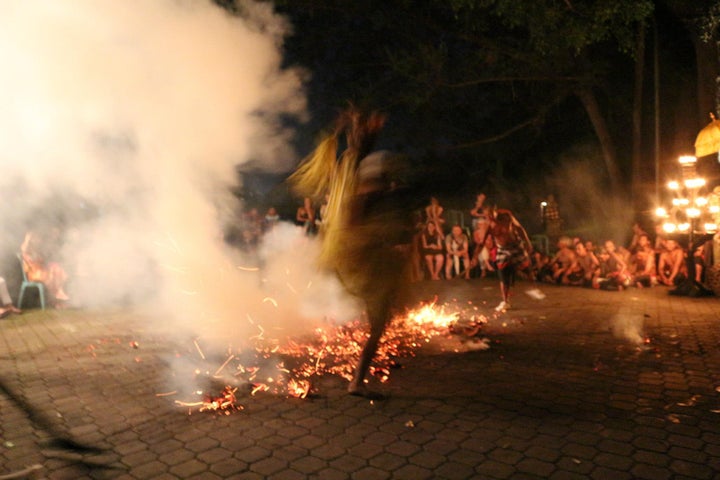
On the day of the full moon festival, which falls once a month when the moon is full, the Balinese gather in their temples to pray and celebrate. We set off with a driver to Ulu Watu as people prepare for the full moon festival. The driver says to us, “Maybe you don’t want to go to Ulu Watu? It is far, about two hour’s drive. Why don’t you stay in the Ubud area and I will show you a few temples and take you to Kecak in Ubud. In Ulu Watu the Kecak is for the tourists. They do not go into a trance there. For real Kecak you must pray the entire day before you sing. They don’t do that in Ulu Watu.”
I insist on going to Ulu Watu.
I should have listened to the driver.
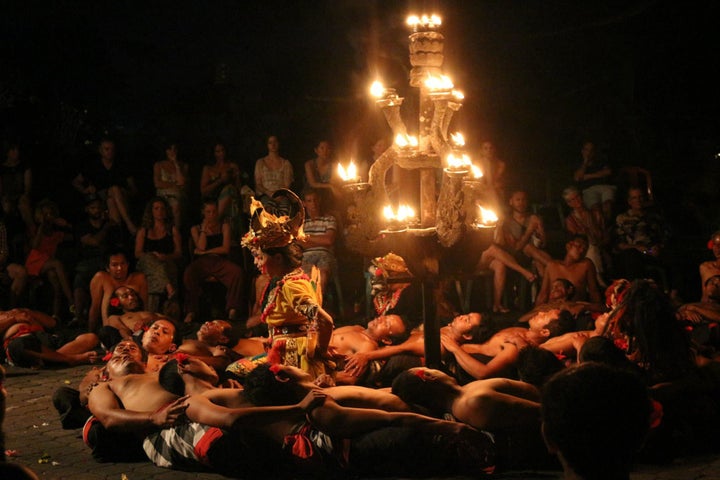
Although the sunset is beautiful, and although I do catch a glimpse of the temple on the steep cliff over the sea, this Kecak does not have the spiritual power of the performance I’d seen a year ago in Ubud. Last year every evening I'd go to a local temple to listen to gamelan or bamboo gamelan orchestras accompanied by Ledong dancers. As I watched these magical performances under a star-filled sky I would marvel at how the traditional music and dance of Bali was still an important part of the indigenous culture. Children would arrive at the temple in ethnic costume and would play along the edges of the stage until it was their turn to go on stage and dance. After the performances the young musicians, still dressed in their performance sarongs and head gear, would climb onto their mopeds, and with their wives with sleeping babies in their arms, and possibly an older child clinging to their back, speed home along the dark winding roads. Gamelan, and the Kecak performance in Ubud, was a communal experience that is integrated into daily life and the Balinese belief system.
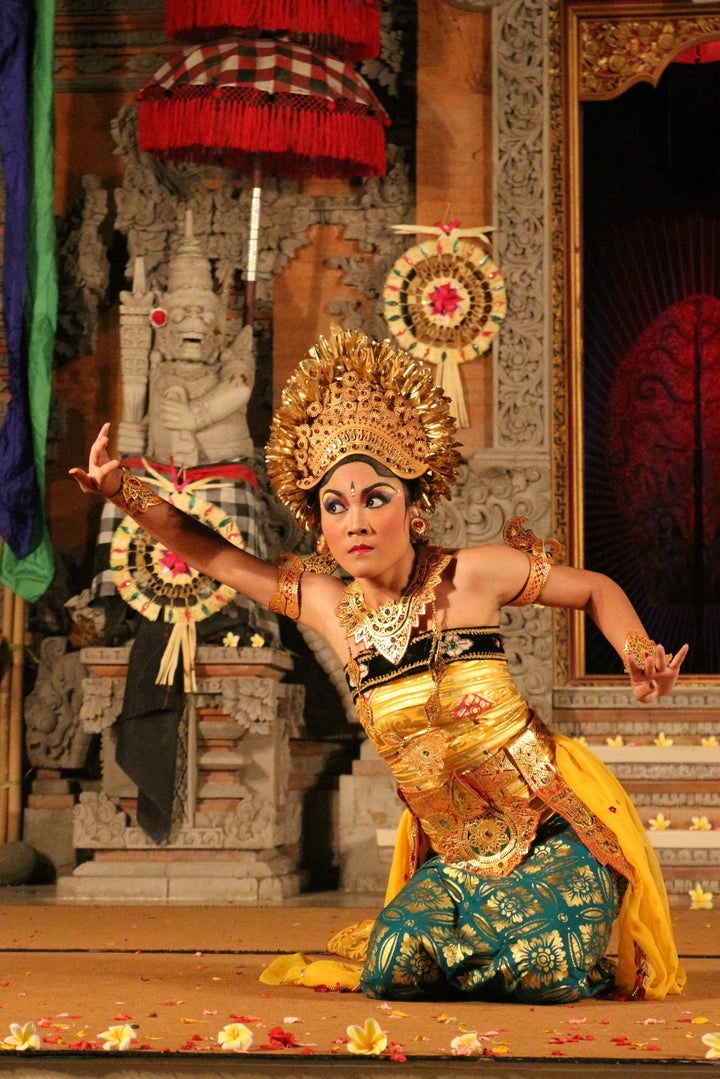
The Ulu Watu Kecak performance takes place in a crowded arena with tourists coming in and out of the performance area with no respect for the performers. At times, they practically step on the crouching singers in the circle. People in the audience talk to each other in loud voices as the performance is taking place, take selfies, hold up their iPads to film the show, not concerning themselves about blocking other people’s view. But the worst came at the end, when instead of walking on flames, the ritual disintegrates into a poor circus show with the monkey king surrounded by a ring of fire, leaping up and setting another character’s sarong on fire as that character runs comically from the arena. Here the Kecak had degenerated into a parody of itself.
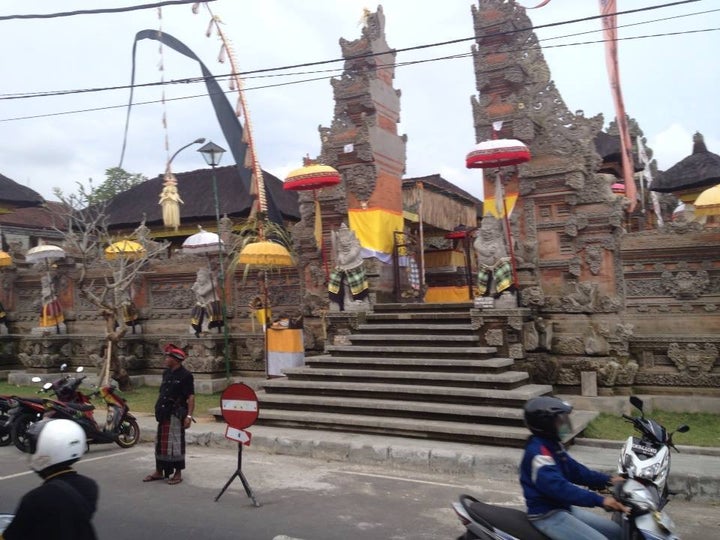
After five magnificent days in Bali, I fly back to Hong Kong. My right index finger is burned from where I spilled boiling wax onto it with a lopsided tjanting tool while painting a batik depicting my moonlit hike up Mount Batur at an artist’s workshop in Ubud. Both my knees are bruised and my right kneecap has a large blue boil-like bruise popping out, the result of a clumsy stumble onto volcanic rubble while coming down Mount Batur. The lower portion of my right palm is still healing from being sliced open after losing my grip on the rock face. But my toe nails are painted purple with white flowers in the Balinese style, and my spirit has been cleansed of all negativity. All that was proof that in Bali I had lived to my life to its maximum potential—that in Bali I had fed the good spirits and had sidestepped the bad.
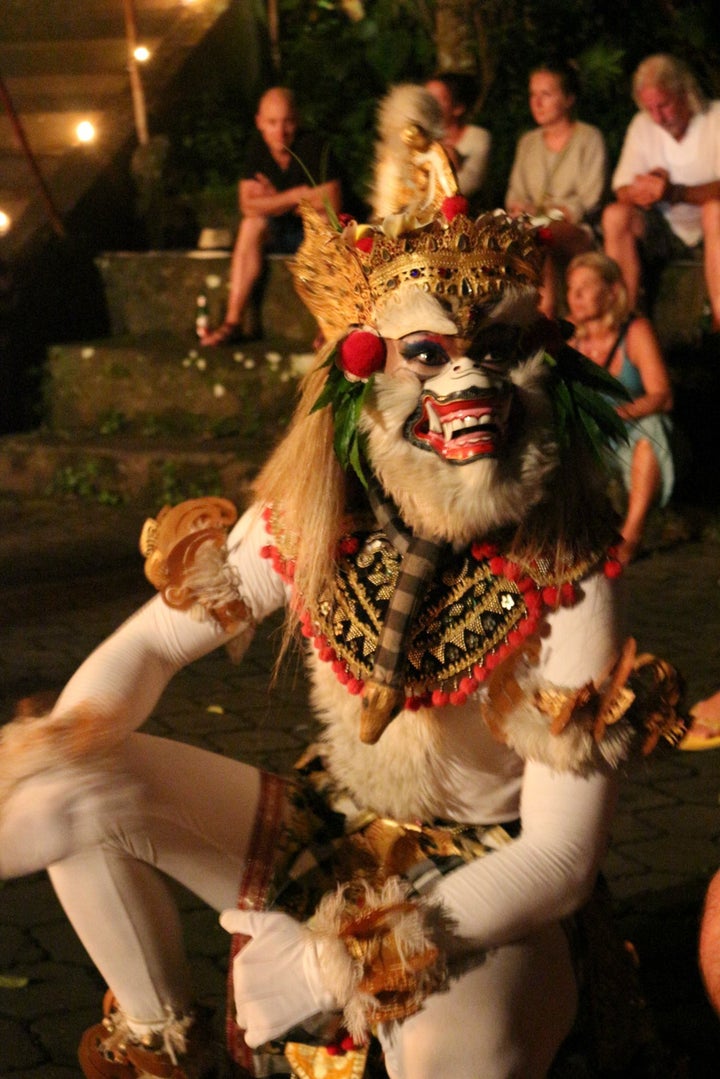
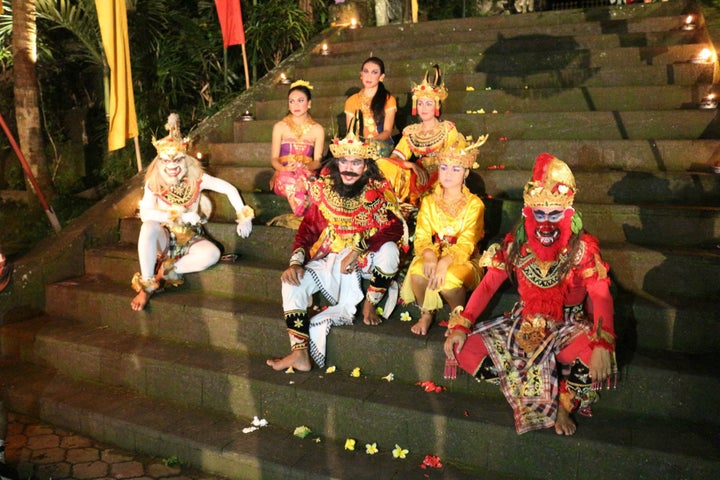
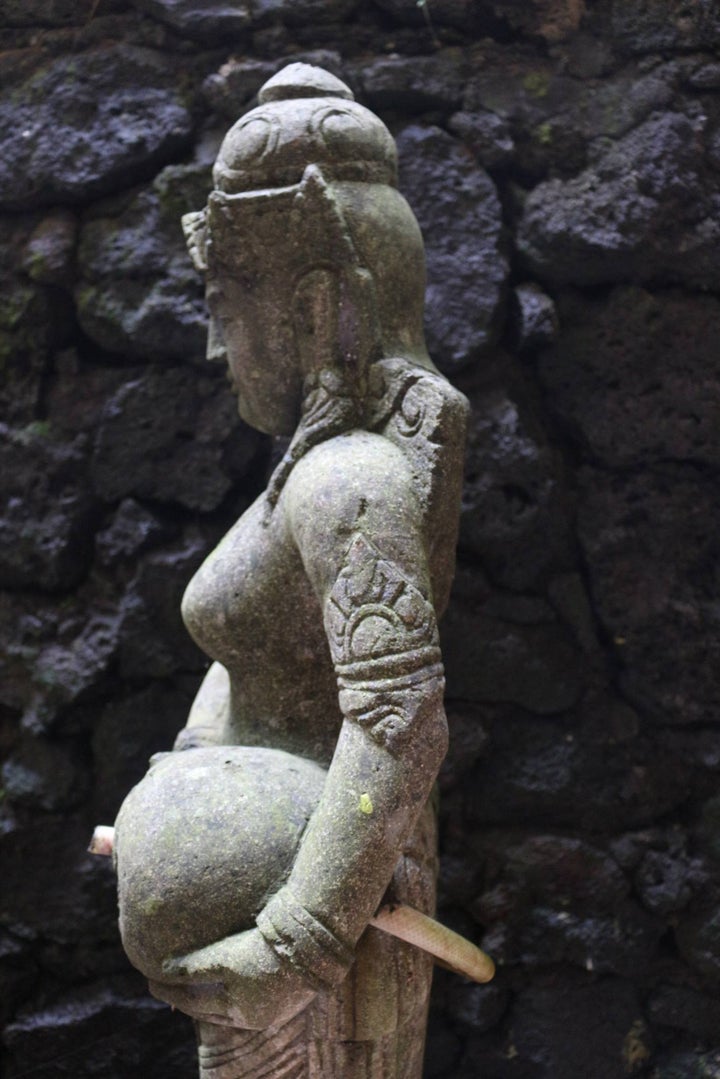
If you would like to read more chapters from DIGGING A HOLE TO CHINA: A MEMOIR ON TEACHING AND TRAVELING please click on the link below:
